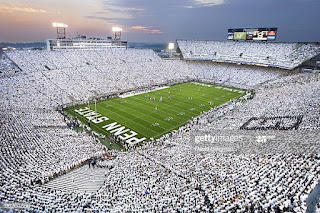College athletics in dire straits? Loss of $375 Million from March Madness cancellation and the potential of fans staying away from football games has changed NCAA athletics dramatically: Is it the end of the NCAA as we knew it? First of a series
Beaver Stadium whiteout: Will they return in the fall?
Photo: Getty Images
So, when the coronavirus entered the United States, and when medical professionals said that the only sure fire way to combat it [without a vaccine] was social distancing, then the decision was simple: Cancel the conference tournaments and even more damaging, the NCAA Basketball Championship.
The money that is raised from that is distributed to the members schools and conferences. And, in late March, the NCAA made an announcement about that loss of money.
$375 million
The Associated Press made the announcement in a story that outlined the problem,
Canceling March Madness because of the coronavirus pandemic will cost the NCAA about $375 million that it would have distributed to 350 schools across the nation.
Some will be able to absorb the losses better than others.
The NCAA announced Thursday it will distribute $225 million to its Division I member schools in June, nearly two-thirds less than the $600 million scheduled to be handed out in installments from April to June.
Schools that compete in the wealthiest conferences, with billion-dollar television contracts fueled by major college football, might not notice much of a difference in the short term.
Schools competing in mid-major conferences are preparing to make sacrifices.
“Pandemic Fallout: NCAA Slashes Distribution by $375
Million,” The Associated Press, March 27, 2020
NCAA has serious issues to confront
The problem for the NCAA is not just monetary, but that is one of the major focuses,
“The association has prepared for a financial catastrophic event like the one we face now,” Drake said. “While we certainly have challenges ahead, we would be in a far worse position had it not been for this long-standing, forward-focused planning.”
Former NCAA executive Greg Shaheen said the association could trim expenses related to the championship events it runs. The NCAA spent $153.8 million to run championship events last year.
“Look at the breadth of the 90 championships and only maybe a half dozen that cover their own costs,” Shaheen said.
“Pandemic Fallout: NCAA Slashes Distribution by $375
Million,” The Associated Press, March 27, 2020
In short, the way that the NCAA is administered will become a major problem. What the athletic directors are concerned about now is that the football season may not take place, or that fans may be unlikely to fill the stands.
That would devastate it.
NCAA had insurance policy
While the loss of $867.5 million from the March Madness cancellation is problematic, is can be assuaged with a little insurance money,
The NCAA pulled in more than $1 billion in revenue last year, including $867.5 million from the television and marketing rights for the Division I men’s basketball tournament. But March Madness was canceled March 19, a week before the first round was scheduled to begin.
The NCAA said $50 million of the distribution will come from its reserve fund while a $270 million event cancellation insurance policy will help pay off the remaining distribution.
The lost revenue was just as jarring in the NCAA’s two lower divisions, filled with smaller schools: Division II was projected to receive $13.9 million, $30 million less than last year, while Division III was expected to receive $10.7 million, $22 million less than last year.
NCAA had insurance policy
While the loss of $867.5 million from the March Madness cancellation is problematic, is can be assuaged with a little insurance money,
The NCAA pulled in more than $1 billion in revenue last year, including $867.5 million from the television and marketing rights for the Division I men’s basketball tournament. But March Madness was canceled March 19, a week before the first round was scheduled to begin.
The NCAA said $50 million of the distribution will come from its reserve fund while a $270 million event cancellation insurance policy will help pay off the remaining distribution.
The lost revenue was just as jarring in the NCAA’s two lower divisions, filled with smaller schools: Division II was projected to receive $13.9 million, $30 million less than last year, while Division III was expected to receive $10.7 million, $22 million less than last year.
“Pandemic Fallout: NCAA Slashes Distribution by $375
Million,” The Associated Press, March 27, 2020
Nevertheless, Div. III and Div. II are in dire straits, moreso than those in the Power 5 conferences.
And, the problem now is that the schools have other financial difficulties beyond athletics. They have lost some serious money over this pandemic, and it will cost them serious money, and students may not be willing to return in the fall.
That is a more vital concern than athletics.
Part 2: Athletic directors have major issues facing them



Comments
Post a Comment